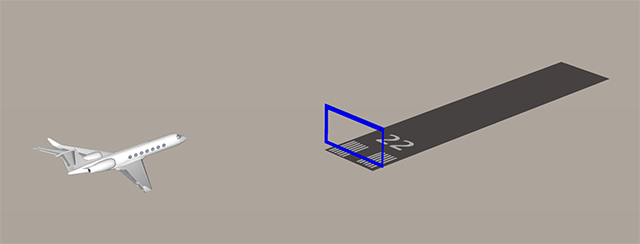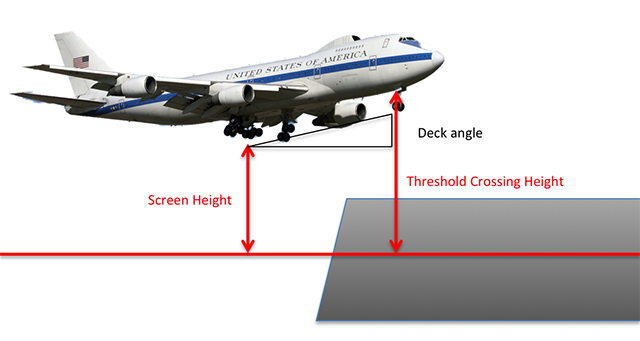The terms "screen height" and "threshold crossing height" are often used interchangeably, and more often than not are not defined at all.
— James Albright

Updated:
2014-11-27

Precision approach path points,
TERPS, Vol 3, ¶1.2.6, figure 1-3.
Screen Height is defined in several places as an imaginary rectangle you fly through on takeoff or landing and that every thing in the airplane passes through. During landing, for example, the landing gear will cross the runway threshold by screen crossing height.
Threshold Crossing Height seems to mean the exact same thing in many manuals, but there are also sources that say it is the height from the end of the runway to the ILS glide slope antenna. The wheels on landing, for example, will be below threshold crossing height. While the approach chart could very well say 50 feet threshold crossing height, the actual height may have been adjusted to accommodate the largest airplane that regularly frequents the airport in question.
It gets worse: while most sources say these heights are defined where the landing surface begins or takeoff surface ends, some use the pavement itself. So the math could be based on a displaced threshold.
Is this a problem? It depends. If you are flying something much smaller than a Boeing 747 you are probably okay. Wherever you go the threshold crossing height will be okay for you. The chart might say 50' and you may find yourself much higher because the chart was designed for somebody else. If you are flying a Boeing 747 into an airport that is designed for a Boeing 737 it could very well be an issue. If you normally use a three-bar VASI you should be able to assume the ILS glide slope was aimed with you in mind. Now if you take that same airplane someplace without three-bar VASI, it could very well be that glide slope was designed for someone else and flying the beam could cause you to land short.
In any case, you should look at: Aim Point vs. Touchdown Point.
1 — Screen Height (SH) defined

1
Screen Height (SH) defined
Screen Height. The height of an imaginary screen which the airplane would just clear at the end of the runway, or runway and clearway, in an unbanked attitude with the landing gear extended.
Source: AC 120-62, ¶6.h.
SCREEN HEIGHT. This is the height of an imaginary screen placed at the end of the TODR or at the beginning of the LDR which an aeroplane with the wings level and the undercarriage extended would just clear.
Source: Swatton, ¶18.5
The JAA books don't really define screen height but imply the wheels will cross the runway edge at screen height.
2
Threshold Crossing Height (TCH) defined
THRESHOLD CROSSING HEIGHT− The theoretical height above the runway threshold at which the aircraft's glideslope antenna would be if the aircraft maintains the trajectory established by the mean ILS glideslope or MLS glide path.
Source: FAA Pilot/Controller Glossary, PCG, 8/22/13
3
Screen Height (SH) = Threshold Crossing Height (TCH)?
U.S. and JAA certification manuals are unclear about what exactly needs to hanging over the runway's edge for takeoff or landing. You can find ample evidence that it is (and should be) the wheels. But you can also conclude it is the ILS glide slope antenna on landing. Is this important?
In the case of a very large airplane, it could be. If, for example, the ILS glide slope antenna in a Boeing 747 is just aft of the nose gear (as it is for many of them) then the wheels are 100' aft and 10' lower. The difference between the antenna and the wheels for a 5° deck angle would be 100 tan (5°) + 10 = 19 feet.
In the case of a smaller aircraft, perhaps it is nothing to be concerned about. In most Gulfstreams, for example, the glide slope antenna is about 40 feet forward and 5 feet higher than the aft wheels. The difference between the antenna and the wheels for a 5° deck angle would be 40 tan (5°) + 5 = 7 feet.
The runway's glide slope antenna should be placed so as to make up for the difference where large aircraft are expected, but you really won't know this. What to do? You will have to decide for yourself. As for me:
- Back when I flew Boeing 747's I flew the glide path as published where I knew there were three-bar VASI, reasoning the runway was set up for aircraft with large eye wheel heights. If the runway did not have three-bar VASI I suspected I might have a problem and might choose to fly a quarter-dot high on the glide path.
- These days, flying a G450, I know the discrepancy is small. I try very hard to stay on glide path and don't worry about the fact the threshold crossing height might bring my gear 47 feet over the runway versus 50.
References
(Source material)
14 CFR 1, Title 14: Aeronautics and Space, Definitions and Abbreviations, Federal Aviation Administration, Department of Transportation
14 CFR 25, Title 14: Aeronautics and Space, Airworthiness Standards: Transport Category Airplanes, Federal Aviation Administration, Department of Transportation
Advisory Circular 91-79, Runway Overrrun Prevention, 11/06/07, U.S. Department of Transportation
Advisory Circular 120-62, Takeoff Safety Training Aid, 9/12/94, U.S. Department of Transportation
Aeronautical Information Manual
FAA Pilot/Controller Glossary, PCG, 8/22/13
Joint Aviation Authorities JAR-OPS 1, Commercial Air Transportation (Aeroplanes), 10 May 2007
Swanson, P. J., "Aircraft Performance Theory for Pilots," Blackwell Science Ltd, a Blackwell Publishing Company, 2000.
United States Standard for Terminal Instrument Procedures (TERPS), Federal Aviation Administration 8260.3B CHG 25, 03/09/2012

